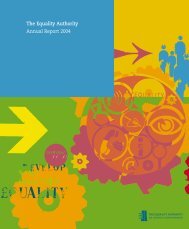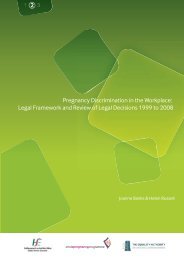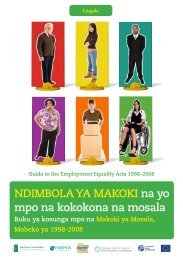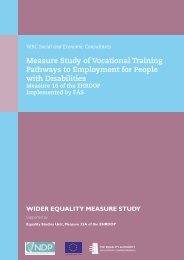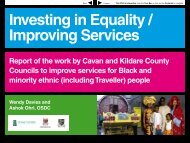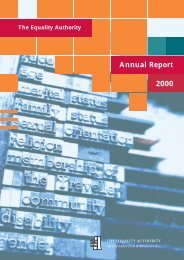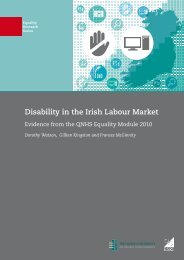Pregnancy and Employment: A Literature Review - Crisis Pregnancy ...
Pregnancy and Employment: A Literature Review - Crisis Pregnancy ...
Pregnancy and Employment: A Literature Review - Crisis Pregnancy ...
You also want an ePaper? Increase the reach of your titles
YUMPU automatically turns print PDFs into web optimized ePapers that Google loves.
<strong>Pregnancy</strong> <strong>and</strong> <strong>Employment</strong>: A <strong>Literature</strong> <strong>Review</strong><br />
Under British law employers are required to carry out a risk assessment for all pregnant women. It was estimated<br />
that in 55% of cases, employers did not carry out risk assessments, failed to pick up risks as part of the assessment<br />
or failed to address the risks identified. Poor levels of risk assessment were most common in the business sector<br />
<strong>and</strong> among professional occupations, <strong>and</strong> for women working more than 40 hours a week, with less than one<br />
year’s tenure <strong>and</strong> with high earnings prior to pregnancy.<br />
Employers’ flexibility towards new mothers was also assessed. Overall, 19% of women reported that they had not<br />
been allowed time off to cope with the illness of their baby or had been denied the opportunity to work more<br />
flexibly on their return to work. Lack of flexibility was particularly high among professional <strong>and</strong> managerial women<br />
<strong>and</strong> in the manufacturing <strong>and</strong> transport sectors.<br />
Impact on decision to return to work<br />
The EOC survey found a relationship between treatment while pregnant <strong>and</strong> women’s decision to return to work. 10<br />
Overall, 81% of mothers in the sample had returned to work by the time of the survey. Of the women who returned<br />
to work as employees (n=799), 59% felt that their employer was very supportive of the fact that they had a young<br />
child, 26% said their employer was supportive, <strong>and</strong> 13% felt their employer was not supportive.<br />
Over three-quarters (77%) of those who stated that their employer was very supportive or supportive during<br />
pregnancy had returned to work at the time of the interview, compared to 63% who stated that their employer was<br />
not supportive (Adams et al, 2005). Hogarth <strong>and</strong> Elias’s analysis of the same survey data suggests that women who<br />
were dismissed as a result of pregnancy (type A discrimination) were less likely to have returned to work within the<br />
period of observation: 62% as opposed to 75% (Hogarth & Elias, 2005, p15). However, women who reported type<br />
B discrimination – ‘financial loss’ – were more likely to have returned to work by the time of the survey (87%). It is<br />
possible that this result arises because the women experiencing financial loss were more likely to be high earners<br />
<strong>and</strong> to have higher educational qualifications, characteristics that increase women’s chances of returning to work.<br />
As the authors do not control for other characteristics in a model, it is not possible to attribute the differences<br />
identified in women’s propensity to return to work to the manner in which they were treated during pregnancy.<br />
Lack of employer flexibility was found to increase the likelihood of leaving work subsequent to the return (Adams<br />
et al, 2005, p67).<br />
Loss of income<br />
Another significant impact of discrimination was the loss of earnings experienced by those who were dismissed/<br />
made redundant or pushed out of work because of their pregnancy. The problem is exacerbated by the difficulty<br />
women face in obtaining another job while pregnant (EOC, 2005, p24). Similarly, those who report problems such<br />
as demotion, pay cuts, having their shifts cut without agreement <strong>and</strong> being forced to go on maternity leave or sick<br />
leave earlier than they wanted to will also have experienced financial losses.<br />
Additionally, women dismissed before 26 weeks of pregnancy were calculated to have lost an average of £2,210 in<br />
statutory maternity pay (Hogarth & Elias, 2005, p.iv). As well as the immediate cost, the authors report that women<br />
who recorded discrimination of type A or B experienced a lower rise in their earnings on return to work than those<br />
who were not discriminated against (although, again, other relevant factors are not controlled for in this analysis).<br />
Furthermore, those who experienced dismissal as a result of pregnancy were less likely to return to work at all, <strong>and</strong><br />
those who did return spent longer out of the labour market. Both of these factors are likely to depress women’s<br />
earnings in the longer term (ibid).<br />
2.4 Unfair Treatment: Findings of Maternity Rights Surveys (UK)<br />
The Maternity Rights Survey series in the UK has been monitoring women’s take-up of maternity benefits <strong>and</strong><br />
women’s employment pre <strong>and</strong> post-birth since the late 1970s. We focus here on the four most recent surveys,<br />
carried out in 1996 (Callender et al, 1997), 2002 (Hudson et al, 2004), 2005 (Smeaton & Marsh, 2006) <strong>and</strong> 2007<br />
(La Valle et al, 2008). The methodology of the survey changed over the period, from a postal survey in 1996<br />
<strong>and</strong> 2002 to a telephone survey in 2005, to a face-to-face, computer-assisted interview in 2007. The content<br />
of the questionnaires <strong>and</strong> the wording of questions also changed from year to year, which means that precise<br />
10 We discuss the findings relating to women’s decision to return to work <strong>and</strong> their post-birth employment conditions in Chapters 3 & 4.<br />
PAGE 15




